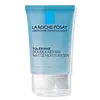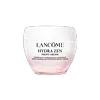La Roche-Posay Toleriane Double Repair Matte Face Moisturizer for Oily Skin Versus Lancôme Hydra Zen Moisturising And Soothing Night Cream
What's inside
What's inside
 Key Ingredients
Key Ingredients

 Benefits
Benefits

 Concerns
Concerns

 Ingredients Side-by-side
Ingredients Side-by-side

Water
Skin ConditioningGlycerin
HumectantSilica
AbrasiveBetaine
HumectantNiacinamide
SmoothingCetearyl Isononanoate
EmollientZea Mays Starch
AbsorbentCeramide NP
Skin ConditioningCarbomer
Emulsion StabilisingGlyceryl Stearate Citrate
EmollientSodium Hyaluronate
HumectantSodium Hydroxide
BufferingPerlite
AbsorbentHydroxyacetophenone
AntioxidantCaprylyl Glycol
EmollientXanthan Gum
EmulsifyingWater
Skin ConditioningGlycerin
HumectantPropylene Glycol
HumectantButyrospermum Parkii Butter
Skin ConditioningDimethicone
EmollientOryza Sativa Bran Oil
EmollientSilica
AbrasiveCI 14720
Cosmetic ColorantZea Mays Oil
EmulsifyingLecithin
EmollientTocopheryl Acetate
AntioxidantSodium Hyaluronate
HumectantSodium Hydroxide
BufferingHydroxypalmitoyl Sphinganine
Skin ConditioningPhenoxyethanol
PreservativeStearalkonium Hectorite
Gel FormingPaeonia Suffruticosa Extract
Skin ConditioningEugenol
PerfumingTriticum Vulgare Germ Oil
EmollientTriticum Vulgare Germ Extract
Skin ConditioningChlorphenesin
AntimicrobialPolysorbate 80
EmulsifyingPolycaprolactone
StabilisingPoloxamer 188
EmulsifyingDimethiconol
EmollientAmmonium Polyacryloyldimethyl Taurate
Emulsion StabilisingLimonene
PerfumingBenzyl Alcohol
PerfumingIsohexadecane
EmollientPropylene Carbonate
Solvent2-Oleamido-1,3-Octadecanediol
Skin ConditioningAlpha-Isomethyl Ionone
PerfumingAcrylamide
Acrylates/C10-30 Alkyl Acrylate Crosspolymer
Emulsion StabilisingCeramide NP
Skin ConditioningMoringa Oleifera Seed Extract
Skin ConditioningSesamum Indicum Oil Unsaponifiables
EmollientDisodium EDTA
Rosa Gallica Callus Extract
AntioxidantOctyldodecanol
EmollientButylene Glycol
HumectantCitronellol
PerfumingParfum
MaskingWater, Glycerin, Propylene Glycol, Butyrospermum Parkii Butter, Dimethicone, Oryza Sativa Bran Oil, Silica, CI 14720, Zea Mays Oil, Lecithin, Tocopheryl Acetate, Sodium Hyaluronate, Sodium Hydroxide, Hydroxypalmitoyl Sphinganine, Phenoxyethanol, Stearalkonium Hectorite, Paeonia Suffruticosa Extract, Eugenol, Triticum Vulgare Germ Oil, Triticum Vulgare Germ Extract, Chlorphenesin, Polysorbate 80, Polycaprolactone, Poloxamer 188, Dimethiconol, Ammonium Polyacryloyldimethyl Taurate, Limonene, Benzyl Alcohol, Isohexadecane, Propylene Carbonate, 2-Oleamido-1,3-Octadecanediol, Alpha-Isomethyl Ionone, Acrylamide, Acrylates/C10-30 Alkyl Acrylate Crosspolymer, Ceramide NP, Moringa Oleifera Seed Extract, Sesamum Indicum Oil Unsaponifiables, Disodium EDTA, Rosa Gallica Callus Extract, Octyldodecanol, Butylene Glycol, Citronellol, Parfum
 Reviews
Reviews

Ingredients Explained
These ingredients are found in both products.
Ingredients higher up in an ingredient list are typically present in a larger amount.
Ceramide NP is a type of ceramide and formally known as ceramide 3.
Ceramides are intercellular lipids naturally found in our skin that bonds dead skin cells together to create a barrier. They are known for their ability to hold water and thus are a great ingredient for dry skin.
Ceramides are an important building block for our skin barrier. A stronger barrier helps the skin look more firm and hydrated. By bolstering the skin ceramides act as a barrier against irritating ingredients. This can help with inflammation as well.
If you would like to eat ceramides, sweet potatoes contain a small amount.
Read more about other common types of ceramides here:
Ceramide AP
Ceramide EOP
Glycerin is already naturally found in your skin. It helps moisturize and protect your skin.
A study from 2016 found glycerin to be more effective as a humectant than AHAs and hyaluronic acid.
As a humectant, it helps the skin stay hydrated by pulling moisture to your skin. The low molecular weight of glycerin allows it to pull moisture into the deeper layers of your skin.
Hydrated skin improves your skin barrier; Your skin barrier helps protect against irritants and bacteria.
Glycerin has also been found to have antimicrobial and antiviral properties. Due to these properties, glycerin is often used in wound and burn treatments.
In cosmetics, glycerin is usually derived from plants such as soybean or palm. However, it can also be sourced from animals, such as tallow or animal fat.
This ingredient is organic, colorless, odorless, and non-toxic.
Glycerin is the name for this ingredient in American English. British English uses Glycerol/Glycerine.
Learn more about GlycerinSilica, also known as silicon dioxide, is a naturally occurring mineral. It is used as a fine, spherical, and porous powder in cosmetics.
Though it has exfoliant properties, the function of silica varies depending on the product.
The unique structure of silica enhances the spreadability and adds smoothness, making it a great texture enhancer.
It is also used as an active carrier, emulsifier, and mattifier due to its ability to absorb excess oil.
In some products, tiny microneedles called spicules are made from silica or hydrolyzed sponge. When you rub them in, they lightly polish away dead skin layers and enhance the penetration of active ingredients.
Learn more about SilicaSodium Hyaluronate is hyaluronic acid's salt form. It is commonly derived from the sodium salt of hyaluronic acid.
Like hyaluronic acid, it is great at holding water and acts as a humectant. This makes it a great skin hydrating ingredient.
Sodium Hyaluronate is naturally occurring in our bodies and is mostly found in eye fluid and joints.
These are some other common types of Hyaluronic Acid:
Learn more about Sodium HyaluronateSodium Hydroxide is also known as lye or caustic soda. It is used to adjust the pH of products; many ingredients require a specific pH to be effective.
In small amounts, sodium hydroxide is considered safe to use. However, large amounts may cause chemical burns due to its high alkaline.
Your skin has a natural pH and acid mantle. This acid mantle helps prevent harmful bacteria from breaking through. The acid mantle also helps keep your skin hydrated.
"Alkaline" refers to a high pH level. A low pH level would be considered acidic.
Learn more about Sodium HydroxideWater. It's the most common cosmetic ingredient of all. You'll usually see it at the top of ingredient lists, meaning that it makes up the largest part of the product.
So why is it so popular? Water most often acts as a solvent - this means that it helps dissolve other ingredients into the formulation.
You'll also recognize water as that liquid we all need to stay alive. If you see this, drink a glass of water. Stay hydrated!
Learn more about Water